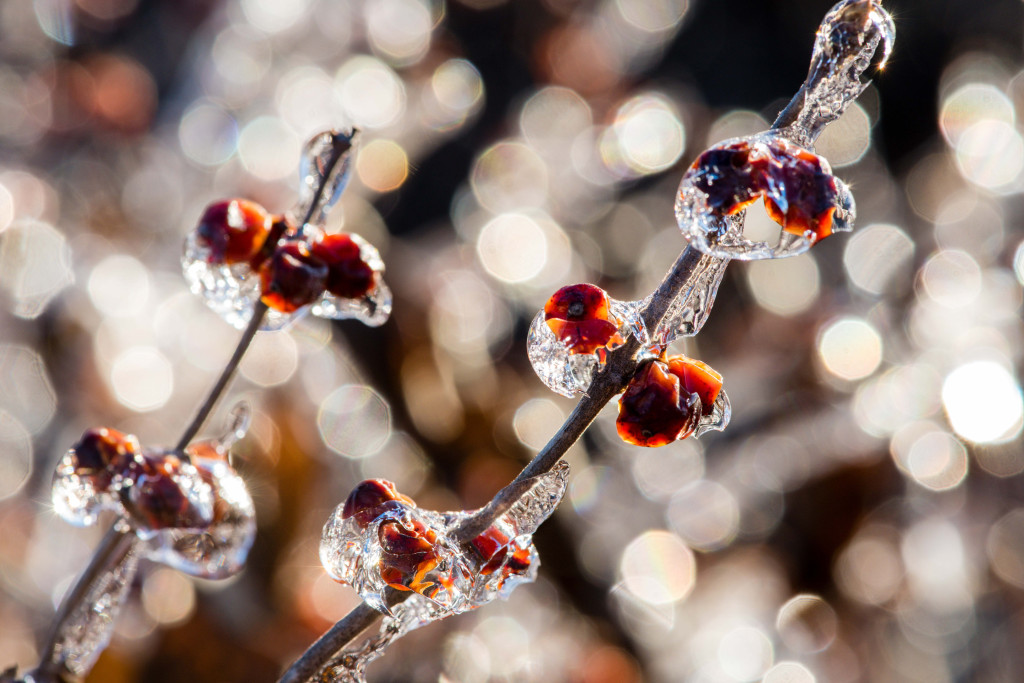
By Monica Macoubrie, Wildlife Education Specialist
As winter blankets the landscape with frost and snow, the survival instincts of wildlife kick into high gear. In this season of scarcity, the availability of quality habitats becomes crucial for the well-being and sustenance of various species. From birds and mammals to insects and aquatic life, each organism seeks refuge in habitats that provide warmth, food and protection from the elements.
Let’s explore the elements that make the best winter habitats for wildlife.
Year-Round Shelter – Evergreen Trees
Evergreen trees are known as the quintessential winter tree, with their bushy foliage, hardiness and resilience to harsh elements. Wildlife have learned to use evergreens for shelter year-round. As deciduous trees shed their leaves, evergreens retain theirs, creating a reliable haven for birds, mammals and insects even during winter. Evergreen trees include species like pine, spruce and fir.
The dense foliage of evergreen trees acts as a natural barrier against harsh winds and provides excellent thermal cover, or insulation, against the cold. Birds utilize the protection of evergreens to roost and conserve energy during chilly nights. Because evergreens do not lose their foliage, they also make ideal nesting sites for not only songbirds, but also owls and hawks that use the high vantage points to keep a watchful eye on potential prey. The shelter provided by these trees supports breeding success and contributes to the overall health of bird populations.
The thermal cover provided by evergreens also plays a key role in helping small mammals, such as squirrels and rabbits, maintain stable body temperatures, which reduces the risk of hypothermia in extreme winter conditions.
The needles of evergreen trees also provide a valuable source of nutrition for animals year-round. These needles are rich in essential nutrients, including vitamin C, which can be particularly scarce in the winter. Foraging creatures such as deer, elk and rabbits turn to evergreen needles when other food sources are buried under snow or simply unavailable.
Coniferous trees harbor an abundance of cones, seeds and insects, all of which serve as vital food sources. Species such as chickadees, nuthatches and crossbills are well-adapted to extracting seeds from pinecones, ensuring access to a consistent supply of energy-rich nutrition during the colder months.
Wetlands as Winter Retreats
Everyone loves a buffet, even wildlife. Wetlands in Nebraska are teeming with life and even as winter descends, wetlands transform into bustling havens for wildlife. With limited food available in other habitats, wetlands are nature’s 24/7, all-you-can-eat diner, if you will.
While the surface may freeze, the water beneath wetlands remains relatively stable, providing a refuge for fish and other aquatic organisms. Some fish species, like northern pike, actively swim beneath the ice, while others, such as certain amphibians, may burrow into the mud at the bottom of wetlands, entering a state of dormancy until the warmer months return. Without these wetland areas, many of these aquatic species would cease to exist in Nebraska.
Aquatic vegetation, insects and invertebrates also thrive beneath the surface of the water, providing a rich and reliable food source for a myriad of wildlife. Waterfowl flock to wetlands where submerged plants and aquatic invertebrates become essential components of their winter diets. Foraging animals, such as muskrats and beavers, also benefit from the abundance of plant material in and around wetlands.
Wetlands also serve as critical wintering grounds for numerous migratory bird species. As temperatures drop in the northern regions, waterfowl embark on impressive journeys to warmer locales. Wetlands provide a safe haven where these birds can rest, feed and find shelter. The protected waters of wetlands offer ideal conditions for waterfowl to navigate the winter months, ensuring their survival until the return of spring.
The unique properties of wetlands, with their water bodies and abundant vegetation, contribute to thermal regulation. The water in wetlands retains heat, preventing extreme temperature fluctuations. This thermal stability is particularly important for cold-blooded animals such as amphibians and many fish species, which may remain active in winter, albeit at a slower pace. Additionally, the warmth from wetlands can create microclimates that benefit a variety of wildlife seeking refuge from the winter chill. Wetlands often may be overlooked in the winter months, but they truly are an impressive and critical sanctuary for wildlife in winter.
Winter Wanderers – Expansive Open Spaces
You would think many creatures avoid wide open spaces in the harsh times of winter, but in reality, expansive prairies and snowy meadows become havens for various species during the colder months. Open spaces, such as meadows and grasslands, provide essential grazing grounds for herbivores, which other locales may be lacking this time of year. Animals such as deer, elk and bison venture into these expanses to find patches of grasses and other vegetation protruding through the snow. The wide-open spaces allow them to forage efficiently, sustaining their nutritional needs through the winter.
Open spaces also serve as gathering grounds for social species, fostering interactions and communication among wildlife, especially among large herbivores that form groups for increased protection against predators. Birds, such as flocks of geese or starlings, also leverage expansive spaces for coordinated flight patterns and intricate social behaviors. The wide-open spaces allow them to communicate with each other to regroup, if need be, on their long journeys.
Predators such as wolves, coyotes and birds of prey use expansive, open spaces as critical hunting grounds during the winter. The lack of dense vegetation and the uniformity of the landscape make it easier for predators to spot prey and execute strategic hunting tactics, ensuring their survival in the colder months.
The winter retreats of wildlife unveil a tapestry of resilience, adaptation and instinctive behaviors. Nature’s scarcity during the colder months showcases the remarkable ways in which animals navigate the challenges of winter, inspiring awe and appreciation for the delicate balance that sustains life even in the harshest conditions.
